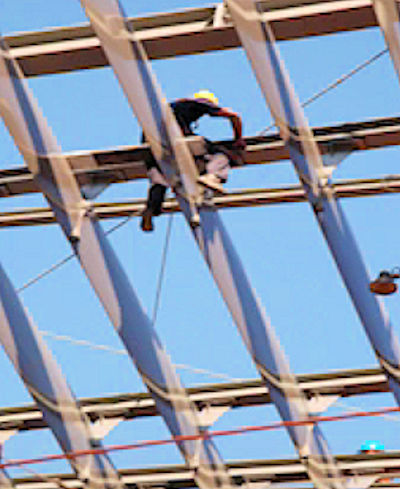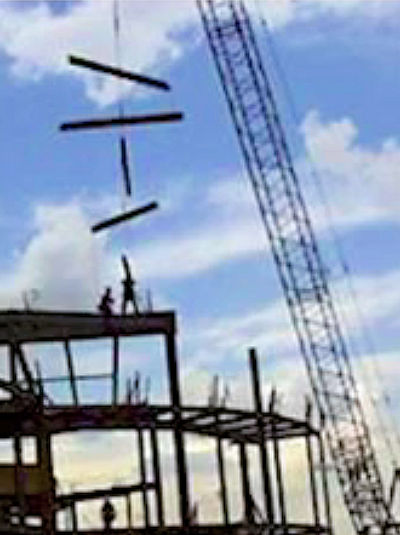SECTION 28 - STEEL ERECTION
28.A General.
The fall protection threshold height requirement is 6 ft (1.8 m) for ALL work covered by this manual, unless specified differently below, whether performed by Government or Contractor work forces, to include steel erection activities and systems- engineered activities (prefabricated) metal buildings. > See Section 21.
28.A.01 Construction loads must not be placed on a structure or portion of a structure unless the employer determines, based on information from a person who is qualified in structural design, that the structure or portion of the structure is capable of supporting the loads.
28.A.02 Employees must not be permitted to work above or in positions exposed to protruding reinforcing steel, fasteners, or other impalement hazards unless provisions have been made to control the hazard.
28.A.03 No employee must be permitted to work under bundled material loads or other suspended loads. Riggers securing lower loads to multi-lift rigging assemblies and workers setting suspended structural components such as beams, trusses, and precast members are excluded from this requirement. In these cases, work controls should be used to minimize the time spent directly under loads.
28.B Structural Steel Assembly.
28.B.01 Prior to beginning the erection of any structural steel, a Steel Erection Plan must be submitted to the GDA for review and acceptance. The plan will include the identification of the site and project; and will be signed and dated by the Qualified Person (QP) responsible for its preparation and modification. This plan must include the following information, as applicable to the particular project.
- The sequence of erection activity, developed in coordination with the Controlling contractor, that includes the following:
- (1) Material deliveries;
- (2) Material staging and storage; and
- (3) Coordination with other trades and construction activities.
- A description of the crane and derrick selection and placement procedures, including the following:
- (1) Site preparation;
- (2) Path for overhead loads; and
- (3) Identification of any lifts classified as critical lifts, requiring separate plans.
- (4) If load handling equipment (LHE) other than crane or derrick (e.g., All-Terrain Forklifts, Powered Industrial Trucks, etc.) is used, it must be used in accordance with the manufacturer's instructions. If LHE is used with rigging, see also Section 16.
- A description of steel erection activities and procedures, including the following:
- (1) Stability considerations requiring temporary bracing and guying;
- (2) Erection bridging terminus point;
- (3) Anchor rod (anchor bolt) notifications regarding repair, replacement and modifications;
- (4) Columns and beams (including joists and purlins);
- (5) Connections;
- (6) Decking; and
- (7) Ornamental and miscellaneous iron.
- A description of the fall protection procedures that will be used;
- A description of the procedures that will be used to comply with this section including;
- (1) Activity hazard analysis in accordance with Section 1 of this manual;
- (2) A certification for each employee who has received training for performing steel erection operations as required by 29 CFR 1926.761;
- (3) A list of the QPs and CPs; and
- (4) A description of the procedures that will be utilized in the event of rescue or emergency response.
Knowledge Check Choose the best answer for the question.
28-1. What must be accomplished prior to beginning the erection of any structural steel?
You forgot to answer the question!


